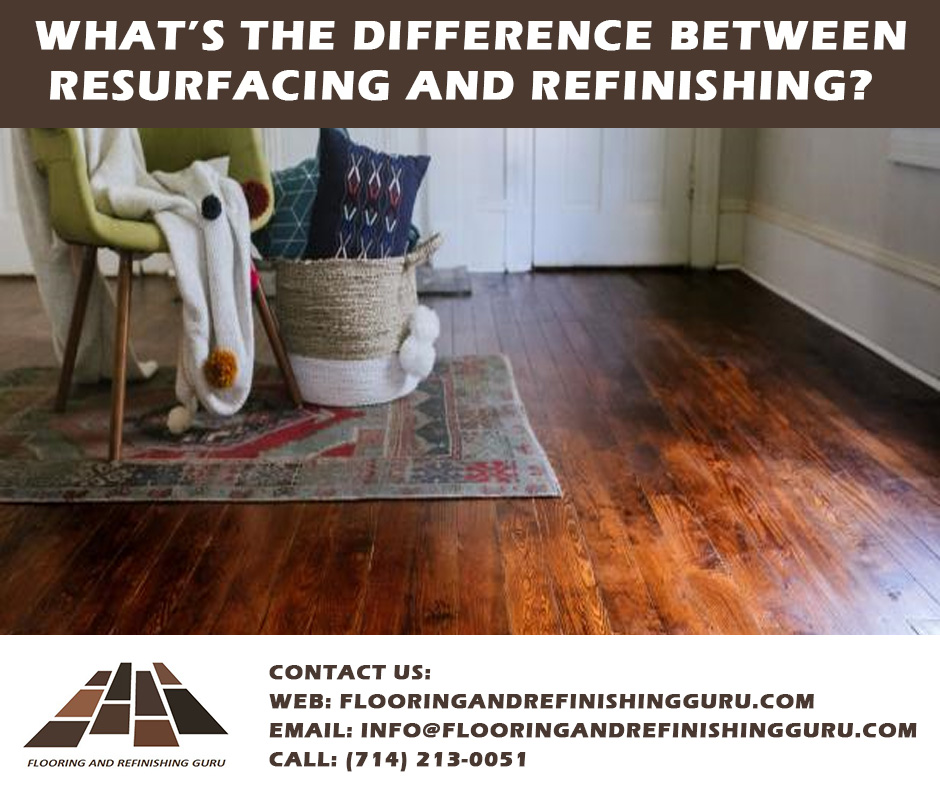
Do you know the difference between minor and major accidents? With regards to time and effort, individuals can heal from bruises and cuts in quick time compared to bed-ridden catastrophes. Revitalize your surfaces with our resurfacing and refinishing expertise. From floors to countertops, we bring new life to your spaces. Similar is the case with resurfacing and refinishing; the former one is used to fix the top-most layer of the floor surface while the latter one involves different processes, such as sanding, staining, sealing, and more.
Besides floors, these methods are used to restore the appearance and functionality of countertops and furniture. While both processes aim to enhance the aesthetic appeal, there are significant differences between resurfacing and refinishing in terms of techniques, materials used, durability, and cost.
What is Resurfacing?
Resurfacing involves the application of a new layer of material over the existing surface. It helps to remove grooves or bumps through different methods, such as eroding, staining, and polishing. This process is feasible for concrete, tile, and wood floors. Following are some steps to resurface floors:
Read More
What is the Easiest Way to Refinish Kitchen Cabinets?
How to Refinish Wood Furniture?
Does Furniture Paint Need Primer?
Surface Preparation
Remove furniture, rugs, and other items from the area; clean the surface to remove dirt, dust, or debris. Examine the floor for any damages, such as cracks, chips, or uneven areas.
Repair & Patch
If there are damages or imperfections, address them before proceeding. Fill in cracks and holes, repair loose boards, and fix issues to ensure a smooth surface.
Sanding or Stripping
Depending on the type of floor and the desired result, you will need to sand or strip the existing finish. This step prepares the surface for the resurfacing process.
Clean & Remove Dust
After sanding or stripping, clean the floor to remove any dust or residue. Vacuuming and damp mopping are used to clear the surface.
Apply Finish
Choose the appropriate finish for your floor, such as stain, paint, or varnish. Follow the manufacturer’s instructions and apply the finish using a brush, roller, or sprayer. Once the final coat is dry, buff or polish the floor to enhance its shine and smoothness.
Cure and Protect
Depending on the type of finish, the floor may need some time to cure. Follow the manufacturer’s guidelines for a durable and attractive surface.
N.B. Use furniture pads or area rugs to protect the resurfaced floor from scratches and damage.
Read More
10 Tips for Refinishing Wooden Furniture
Why Summer Season is the Best Time to Update Your Wooden Flooring?
What Type of Flooring Lasts Longer?
What is Refinishing?
The refinishing process enhances the look and feel of the surface. In other words, the entire area (top and base layers) are modified and redesigned through different processes. If your floor needs a facelift, contact Flooring and Refinishing Guru, one of the best companies in the USA.
Surface Preparation
After clearing the entire area, clean the floor to remove dirt, dust, and debris. Repair any damages, such as cracks or loose boards.
Sanding
Use a floor sander to strip off the old finish and reveal the wood surface. Start with coarse grit sandpaper and switch to finer grits for a smooth result.
Remove Dust & Apply Stain
Vacuum or sweep the surface to eliminate the dust and particulates; wipe the surface with a damp cloth. If you desire a different color or want to enhance the natural wood tone, apply wood stain. Test the stain on a small area first to ensure the desired result.
Apply Finish
Choose a suitable floor finish, such as polyurethane, varnish, or oil-based finish and apply it with a brush, roller, or applicator pad. Follow the manufacturer’s guidelines for the number of coats and drying time between each coat.
Drying & Curing
Give sufficient time to dry and cure. Avoid walking on the floor or placing furniture until it’s cured. For an extra smooth and shiny surface, buff the floor using a floor buffer or polisher.
Differences Between Resurfacing and Refinishing
Use of Materials
Materials are one of the most significant differences between the two processes. Resurfacing involves the application of specialized coatings or materials designed for flat surfaces. On the other hand, Refinishing involves the use of paints, stains, varnishes, or sealants, depending on the surface; these liquids allow for more customization options.
Durability
Durability is a crucial parameter for analyzing the two processes. Resurfaced areas are resistant to chipping, cracking, or peeling. However, exposure to harsh chemicals or abrasive cleaning methods can affect their appearance. Refinished surfaces are more durable than its counterpart. However, they need periodic maintenance and touch-ups for a bright and attractive look.
Cost
Resurfacing is more cost-effective than refinishing: The former requires fewer materials and labor, making it a more budget-friendly option for individuals looking to revamp their surfaces without breaking the bank. Refinishing, on the other hand, involves additional processes like stripping and sanding, as well as multiple coats of finish, which can increase the overall cost of the project.
To know more about refinishing and resurfacing, connect with experts from Flooring and Refinishing Guru.

